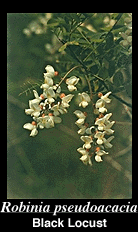LOCUST BLOSSOMS

by bartermn
Robinia pseudoacacia is offering her hanging baskets of blossoms
overhead as I tug on Daisy's lead rope to move her to the other side
of the lawn. The rope had been loosely knotted around the base of
this thorny black locust tree and will (sometime soon, I hope)
be attached to another. I haven't used the lawn mower for years,
the cows are quieter and they seem to enjoy the work. The sweet
smell of the locust blossoms is almost overpowering, especially
when I get a branch hung up in my hair. I should trim those darn limbs!
The Pinnate compound leaves do provide a nice green background
to the clusters of white flowers, especially the youngest, they
resemble ferns. Each branch ends with these bunches, many are
occupied by yellow butterflies. There goes a hummingbird.
"Come On, Miss Daisy! I don't have all day!"
There are only fifty or sixty locust trees left on our homestead.
Hundreds of others have been used as fence posts and firewood
over the years. Our pasture is enclosed by the wedge-split posts,
as is the dairy farmer's down the hill. The scraps from fence post
making and too-small limbs have heated our cabin every winter.
The wood burns a long time and leaves a fine bed of coals, quite
unlike the soft maples and poplar that once helped cover our two
acre homestead. I remember the blossoms threw such a fragrance
when we pitched our tent on this woodlot back in '77 that you
could smell it for miles. If I ever get this cow to move I'll pick
a bouquet for the house.

The lumber from locust trees was the principal wood used for
insulator pins on telephone poles, I have a small collection
of the glass insulators, some blue, others green or clear. They make
great paperweights. One of my favorites still has it's locust pin
inside, perfectly sound after sixty years. Beams cut from locust
were also used for mining timbers and railroad ties throughout
the Appalachians.
Black locust was originally native only to the Appalachian
Mountains and sections of Arkansas, eastern Oklahoma, and
southern Missouri. In its natural range it grows along streams,
in rich bottomlands, and in mountain coves where the soil is
moist and fertile. Locust will grow in just about any soil except
that which is poorly drained or compacted. It has been cultivated
extensively to control erosion, to reclaim strip mine land,
and for ornamental purposes.
Both honey locust and black locust technically belong to the pea
or legume family. However, only the
black
locust has the nodules or knoblike growths on the roots which enable
it to add nitrogen to the soil like such common legumes crops as
clover and soybeans.
"There you go girl. Isn't the grass better on this side
of the lawn?" Now for Rosi...
